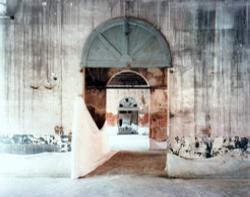Luca Campigotto These fragments I have shored against my ruins T.S. Eliot |
 |
||
They say the heart never dies when it seems as though it should. And that often the joy and the desperation of “carrying on” are inseparable.
I thought about it one night, beneath the Gaggiandre colonnade, while, with my camera positioned, I was waiting for the negative to be sufficiently exposed.
The atmosphere seemed suspended in time. Almost as though the stone heart of the Arsenale was transmitting a sign of survival: a heroic code handed down through the years, of industrial relics and war. And the darkness which surrounded me was, in reality, an epicentre of History.
The water in the large wet dock was still and the air carried few sounds. All at once I looked up, expecting to catch a glimpse of the Chinese cavalry galloping past in the distance. Just as I thought I’d seen them many years before, as I sat on the steps of the Todaro. With their standards billowing in the wind, skimming over the surface of the Bacino, launching their attack in the silence of the dawn.
Maybe, a dream borrowed from someone else. Or, perhaps, the habit of thinking of Venice as a watercolour. The geographical fulcrum of imagination. Where you don’t need to close your eyes to go back in time, anywhere. Right to the limit to which courageous memory - which truly does not die - is able to venture. Amidst voices and glances of other times, in the hidden alley which protects a distant secret. To Harry’s, to sip a Bellini with Colonel Cantwell; gone with Hemingway “across the river”, tired of war, to feel the unforgettable winter wind once again blowing in his face. Or strolling in Piazza San Marco, the most beautiful salon in the world. The day Corto Maltese murmured to himself, between feigned cynicism and melancholy wisdom: “Venice would be the end of me”.
From time to time you do have the feeling that time has passed, going back to look at what was. What by now lies away from us, semisubmerged. Sometimes photography helps to transform an old reflex and invent a new life for things. Going back to search for Eliot’s “fragments”–and every other crumb of Tom Thumb–in the hopes of recomposing something. A nostalgia, or a wound.
Its task is not to tell the truth. But to dwell on things with compassion. To become the material, tangible part of the anxiety with which we look around ourselves. And then, with anger and tenderness, to be a buttress against oblivion, whatever the cost. Like a beast set to guard memories. The night patrol which watches over the remains of the dinosaur …
Its authentic, noble prodigy remains that of giving human beings the gift of an illusion. Confusing the present of the observer with the past in which what is observed is held hostage. That fragment of eternity which belongs to us, and which we ask to see again. A minute later, or many years later. The eyes of our loved ones, our children, the old people we have lost. Because photography is, above all, a heart-consuming journey. The absolute–and ever inescapable–visual dimension of memory. A territory into which you venture seeking the joy and risking the pain of rediscovering with the eye.
Certainly for some of us it is also a deceptive alphabet with which to proceed, in the course of time, to transfigure that which surrounds us. Driven by the pressing desire to continue to look. At everything, in any case, right to the last minute. As if, wandering about the Arsenale with a camera, you could magically find yourself transported to the Marciana library, hunched over an ill-lit table tracing the routes of great travellers. Conjuring up the high seas, the sand, the Indies. The stony heart of the merchant torn between the lust for adventurous wealth and the prudence of staying at home …
It was in Venice, in the late Middle Ages, that Western Christianity embarked on its plans for expanding and discovering the world. And the extraordinary workshop of the Arsenale – the kingdom of carpenters and caulkers – became the nest which produced the galleasses that troubled the slumbers of the Turks.
Later, decadence gave the architecture an atmosphere of expectation. The strength of centuries-long solitude. Today, at the back end of Castello there remains the echo of an unrepeatable splendour. A suffering and grandiose acquafatto. A still beautiful place which looks towards a new life.
from the book L'Arsenale di Venezia, Venice, 2000